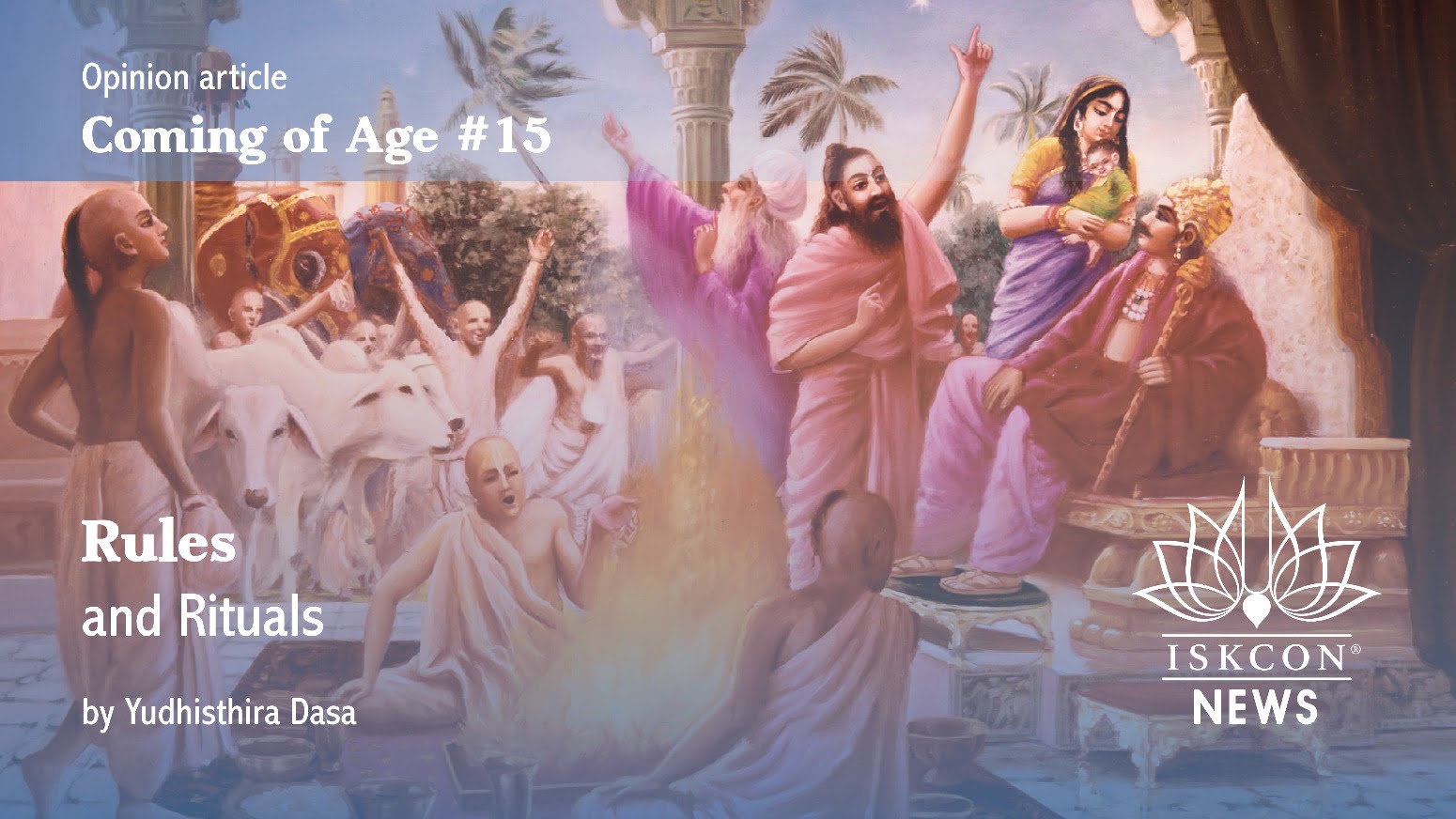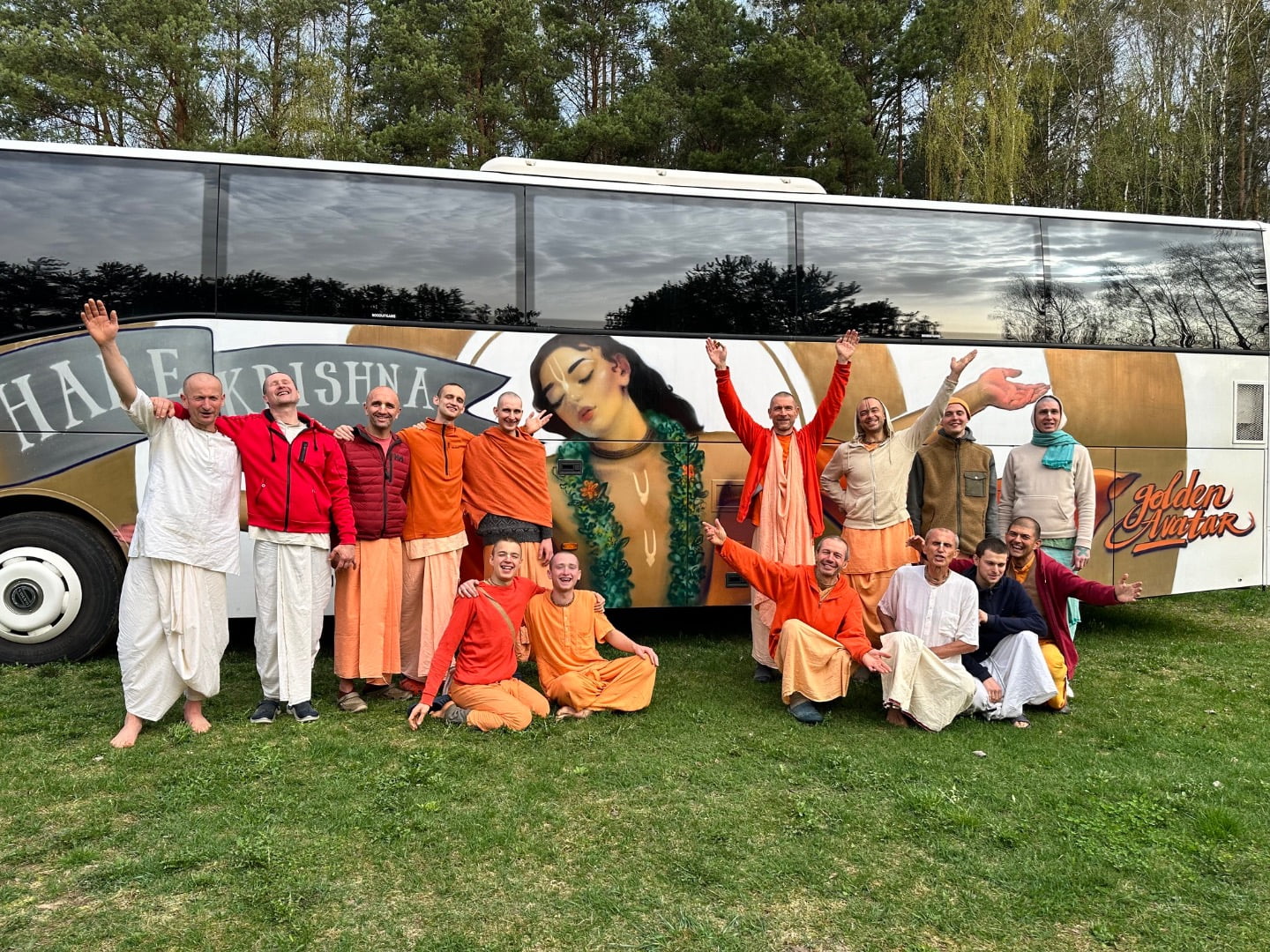Risk Management Within The Devotional Community
By Vaishnava Das | Feb 24, 2012

I am writing this article as a means to increase dialogue within the devotional community with respect to risk management. I do not place myself as an expert in this area though I do have a sensitivity to the subject given my occupation.
What is risk and what is risk management? In general, we may define risk as a hazard or chance of loss. For the purpose of this article I wish to focus on risk as a low frequency, high severity event. Due to the nature of this form of risk the average person may not fully appreciate the dangers in the world.
Yet institutions and leadership must see beyond the life experience of a single individual and must have the foresight to plan for and address such real world events. As an example, insurance companies model future losses in increments of 100-year, 250-year, and 500-year events, each event less likely but more catastrophic. They measure their exposure for such tail-end events and calculate their Probable Maximum Loss (PML). Based on such analyses they take actions to address their risk exposure through various means (price, re-insurance, underwriting, non-renewal etc.).
With this introduction, I wish now to turn the discussion to real world events of recent or near recent memory. For those not familiar with the details of the risks I am highlighting below I would encourage you to research online to see their real world implications.
Alabama Tornado – April 2011
Japan Earthquake & Tsunami – March 2011 (9.0 magnitude)
New Zealand Earthquake – February 2011 (6.3 magnitude)
Australian Floods – December 2010
Indonesian Volcano – October 2010
New Zealand Earthquake – September 2010 (7.3 magnitude)
Pakistan Floods – July 2010
Russian Wildfires– July 2010
European Floods– June 2010
Tennessee Floods– May 2010
China Earthquake – April 2010 (7.1 magnitude)
Iceland Volcano– April 2010
Chile Earthquake– February 2010 (8.8 magnitude)
Haiti Earthquake– January 2010 (7.0 magnitude)
Myanmar Cyclone Nargis – May 2008; 146,000 people killed
Kashmir Earthquake – October 2005 (7.6 magnitude); 79,000 killed
Hurricane Katrina – August 2005
Indian Ocean Tsunami – December 2004 (9.1 magnitude); 230,000 people killed
Ban (Iran) Earthquake – December 2003 (6.6 magnitude); 30,000 people killed
Gujarat Earthquake – January 2001 (7.6 magnitude); 20,000 people killed
Yangtze River Flood – June 1998; 14 million homeless
From a more distant historical perspective we have the Huang He (Yellow River) flood in China in 1931 with an estimated death toll of between 800,000 and 4,000,000; the U.S. flood of 1993 that covered 320,000 square miles; and the Great Mississippi flood of 1927 covering 27,000 square miles etc.
These events can have great impact on the physical infrastructure of the respective countries. But almost assuredly they have a deep impact on the human suffering of their inhabitants. Given the global nature of the devotional community it is simply a matter of when, not if, such an event touches our community. In fact, in some instances, such as Hurricane Katrina (Louisiana temple) and the New Zealand Earthquakes (Christchurch temple) it already has.
So what can we do? The world is inherently risky, but we can take actions as individuals and as communities to prepare for and help mitigate risks. I would request individuals and senior leadership to facilitate mature and capable individuals to help develop a risk preparedness plan.
One of the trends we often witness after catastrophic events is the so-called “Demand Surge” or “Demand Shock” where prices for necessities rise very quickly. This often hits commodity prices such as gas, food, water, and shelter. In the insurance industry it often takes the form of spikes in labor and material prices. Given this phenomenon one solution would be for our temple communities to store a large quantity of surplus food to help aid transition during disaster scenarios. If the program is set up correctly there need not be any economic burden on the temple at all. For instance, temples can build surplus of commonly used foodstuffs (rice, dahl, flour, chickpeas) in bulk and draw them down every week as they prepare for various festivals, feasts, etc. In this manner, through preparation and foresight the temple can address these tail-end scenarios with no additional burden placed upon it.
A point may be raised that individuals should be engaged in this preparation. While I certainly agree this should be done, the reality is that individuals often do not see the risks and are thus under-prepared in the event of a serious event. This is where leadership comes in. A leader is not simply a manager (one dealing with day to day tasks). A leader is someone who has the foresight to see possible scenarios and prepare the larger community for these potentialities. Again, I write this article to help develop a dialogue within the broad devotional community so that mature leadership will emerge to address these possibilities.
Perhaps the most important component of any catastrophic preparation is access to clean, drinkable water. In July 2010 we witnessed the Pakistan floods that covered over 20% of the landed area of that country. What was so tragic was that while they were surrounded by water it was all un-drinkable. Many died from dehydration and water-borne illness. Yet a simple tool such as the Swiss made Katadyn water filter (available for as little as $89) can purify unclean water and remove all sediment and bacteria to produce clean drinkable water. It is available in any outdoor camping store in the West. This is within the purchase capability of any individual and certainly any temple. Will there be a flood one day in Bangladesh? Or Mayapur? Or some other area of the world that will affect the devotional community? It will happen. But if we are prepared we can manage the disruption from such an event. Not all countries will have access to this technology and so I would encourage senior leadership to help facilitate these temples in gaining access to what could be potentially life saving technology.
Our community is global and these global events will one day affect members of our community. Individually we can be prepared and I would recommend each individual develop a catastrophe mitigation plan. Some suggestions would be as follows:
1) Water – It is important to store extra water at home. As previously mentioned I would recommend purchasing a Katadyn water filter (see www.katadyn.com or http://www.amazon.com/Katadyn-Vario-Water-Filter/dp/B001IN3EY2/ref=sr_1_5?ie=UTF8&qid=1325288880&sr=8-5 ). These can be purchased for as little as $89 from your local camping store and will purify any brackish waters you may find. Remember, you can last several weeks without food, but only a few days without water.
2) Food – Most stores operate using “just-in-time inventory” and have no more than 72 hours of food available. When an emergency occurs it will be too late to prepare. However, using a simple FIFO (first in, first out) approach, you can store the necessities with no net burden on your finances. For the most part it is better to purchase raw ingredients rather than prepared foods. To store for 1 adult male, for 1 year, using approximately 2300 calories per day you will need around 695 pounds of stored food. This can be done as follows:
– Grains (400 lbs) – whole wheat, rice, corn meal, pasta, and oats.
– Beans & Legumes (90 lbs) – lentils, black eyed peas, kidney beans, yellow split peas, pinto beans, and sprouting beans (such as mung).
– Milk Powder (75 lbs)
– Cooking Oils (20 lbs)
– Sugars (60 lbs) – sugar, honey, and molasses.
– Salt (5 lbs)
– Misc (45 lbs) – dried fruit, protein powders, peanut butter, wheat gluten, vitamins, baking powder.
– Psychological Foods – During tough times small treats like cocoa, jams, maple syrup, and assorted hard candy can provide a sense of normalcy.
– Infant Formula – For parents with newborn children, it is important to store extra baby formula and toiletries.
Additionally, you should store some canned food such as soups, canned tomatoes (or tomato sauce), canned beans etc. to help when you are too tired to prepare using raw ingredients.
3) Shelter – For around $100 you can purchase a durable camping tent to protect you against the elements. This may be necessary if your existing shelter is destroyed in an earthquake or if you need to vacate your existing area. Additionally, a sleeping bag will help weather the emergency.
4) Cash – Keep $100 in small $1 bills as well as $5-$10 in pocket change as ATMs and banking facilities may not be available.
5) Clothing – Keep an assortment of clothes prepared in case of an emergency. Remember, in the event of an emergency there is a 25% chance it will occur during the winter. Therefore, be prepared with options to protect you against the elements, be they rain or snow.
6) Communication – Keep a battery, solar powered, or hand-cranked powered radio on hand to listen for any emergency broadcasts. Additionally, a simple whistle can be useful to draw attention of rescue support.
7) Toiletries – Set aside a toothbrush and toothpaste, as well as plastic bags for waste disposal. Additionally, simple hand alcohol swabs or gels can help general cleanliness.
8) First AID Kit – These can be purchased and augmented with iodine, bandages, aspirin/Tylenol, and sunscreen.
9) Miscellaneous – Flashlights/lantern, can opener, matches or lighter, camp stove (for outside cooking), utensils (pots, knives, plates), thermos (to hold hot food for later in the day), and maps of the area.
10) Extreme Emergency – I would recommend the purchase of potassium iodide. During the Fukushima reactor meltdown, even though it was on the other side of the earth in Japan, all stores within my U.S. city were sold out within hours of this occurrence. I was told I could be put on a waiting list and the price had risen 10 fold. Potassium Iodide is a simple pill that will prevent radiation saturation of your thyroid system for up to 24 hours. Consult your local natural foods store for supply or check on Amazon.com. Caution: Before taking these pills please read all warnings regarding dosage and possible allergic reactions. Additionally, for those located in flood prone zones I would encourage temples to purchase basic rafting equipment to help in evacuation scenarios.
At the beginning of this article I spoke about modeling events based on 100-year, 250-year, and 500-year probabilities – each event less likely but more catastrophic. Similarly, I beleive we need a response to each of these probabilities. At the lowest level we have individual responsibility to plan for events within their lifetime (100 year). Beyond that we have our city temples plan for events of greater severity (250 year) beyond the experience of a single individual. Finally, as a fall back for extreme emergencies (500 year) our farming communities can act as a final layer of protection for the devotional community.
We must remember that cities depend entirely on rural land for their foods. Our farming communities can greatly serve the devotees in times of disaster through storage of food, wood for heating, and perhaps most importantly seeds. Seeds are such an important element of long-term preparation as they contain within them the means for life itself. I would greatly urge leaders within our farming community to store excess seeds to help assist the larger devotee community in times of need. Additionally, I would urge even individuals to purchase atleast $20-$40 worth of seeds as part of their preparedness kit. For such a small price you can protect your family against very rare emergencies. In the West you can get these at your local supermarket, garden supply store, or even online at Earl May (www.earlmay.com, under Products/Garden Seeds).
I opened this article pointing out the realities of danger in this world focusing principally on natural disasters. However, we must also be conscious of risks stemming from economic and geopolitical threats. Given the global nature of our community it is inevitable that our community will be impacted. Each community will need to assess the risks in their area and make proper plans to address. We cannot prevent these occurences but we can plan for them. Remember, when a disaster occurs it is too late for preparation. It is for this reason that I would urge individuals and senior leadership to develop their own risk mitigation plan to protect your family and the broader devotional community. I hope I have provided some thoughts that will encourage discussion and preparation across the devotee community.














